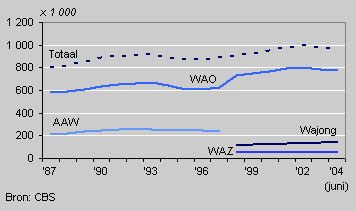Labour disability no longer growing

The number of labour disablement benefits on 30 June 2004 was 968 thousand, 163 thousand more than on 31 December 1987, when 805 thousand labour disablement benefits were paid. In recent years more women started claiming disability benefits (WAO).
Almost 1 million labour disablement benefits
The highest number of labour disability benefits paid was 993 thousand, which was in the fourth quarter of 2002. Then the number started to decrease. The 968 thousand people claiming labour disability on 30 June 2004 included 773 thousand people on WAO-benefits, 140 thousand on benefits for young people with a disability (Wajong) and 55 thousand claiming benefits for disabled self-employed people (WAZ).
Labour disablement benefits, 1987–June 2004

Laws changing
There have been two decreases in the number of benefits since 1987, due to far-reaching changes in the laws governing benefits. The first took place in 1994 and 1995, when laws were introduced to reduce absenteeism due to sickness and labour disability. The second was in 2003 when the Poortwachter Law was introduced.
More women on labour disablement benefits
The increase in the number of WAO-benefits is attributable entirely to women. The number of WAO-benefits paid to women increased from 272 thousand in January 1998 to 356 thousand on 30 June 2004, whereas benefits paid to men fell from 442 to 417 thousand. This decrease is partly due to the fact that more men than women no longer claim WAO benefits because they turn 65. Men aged 55–64 account for half of the number of WAO claimants, while one third of women in that age bracket do.
WAO benefits by sex

The labour participation of women increased drastically in recent years, and with it the chance to end up on disablement benefits. Furthermore women claim these WAO-benefits relatively more often: per 100 women in the labour force the number of WAO-benefits increased from 10 in 1998 to 12 in 2003. The figure for men remained constant in recent years at 10 in 100.
Increase in mental problems
In the period 1998 through June 2004 there was a small shift in the diagnoses of labour disability. In June 2004 mental and behavioural problems were the most frequent diagnoses for WAO-benefits, namely 34 percent. In 1998 this was 31 percent.
WAO benefits by diagnosis

In June 2004 and 1998 about 32 percent of the people were diagnosed as disabled because of disorders of the skeletal and muscular system. The number of disablement benefits granted due to general and endocrine disorders fell from 17 to 13 percent.
Harrie Hartman